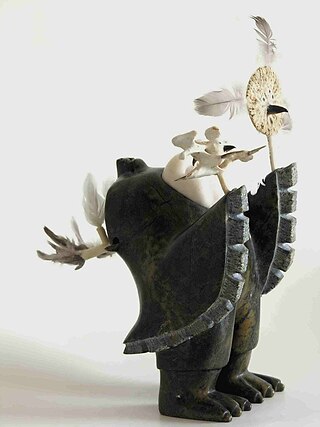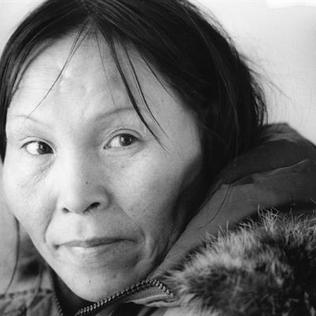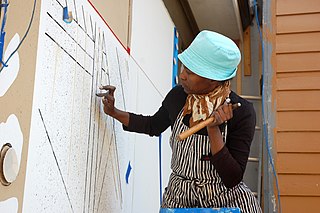
Pitseolak Ashoona was an Inuk Canadian artist admired for her prolific body of work. She was also a member of the Royal Canadian Academy of Arts.

Annie Pootoogook was a Canadian Inuk artist known for her pen and coloured pencil drawings. In her art, Pootoogook often portrayed the experiences of those in her community of Kinngait, in northern Canada, and memories and events from her own life.

Inuit art, also known as Eskimo art, refers to artwork produced by Inuit, that is, the people of the Arctic previously known as Eskimos, a term that is now often considered offensive. Historically, their preferred medium was walrus ivory, but since the establishment of southern markets for Inuit art in 1945, prints and figurative works carved in relatively soft stone such as soapstone, serpentinite, or argillite have also become popular.
The Galeries Ontario / Ontario Galleries (GOG), formerly Ontario Association of Art Galleries / Association Ontarienne des Galeries d’Art (OAAG/AOGA), was established in 1968 to encourage development of public art galleries, art museums, community galleries and related visual arts organizations in Ontario, Canada. It was incorporated in Ontario in 1970, and registered as a charitable organization. It is a successor organization to the Southern Ontario Gallery Group founded in 1947, renamed the Art Institute of Ontario in 1952. In December 2020 Ontario Association of Art Galleries / Association Ontarienne des Galeries d’Art (OAAG/AOGA) rebranded to the name Galeries Ontario / Ontario Galleries (GOG) which included new brand identity, logo, and website to better serve art organizations in Ontario and Canada.

Harbourfront Centre is a key cultural organization on the waterfront of Toronto, Ontario, Canada, situated at 235 Queens Quay West. Established as a crown corporation in 1972 by the Government of Canada to create a waterfront park, it became a non-profit organization in 1991. Funding comes from corporate sponsors, government grants, individual donors and entrepreneurial activities. Harbourfront Centre has a seating capacity of 2,000.
Shary Boyle D.F.A. is a contemporary Canadian visual artist working in the mediums of sculpture, drawing, painting and performance art. She lives and works in Toronto.
Gregory Burke is a New Zealand museum director, writer and curator. In 2013, he was named executive director & CEO of the Mendel Art Gallery, Saskatoon, Canada and the Remai Modern Art Gallery of Saskatchewan.

Janet Kigusiuq was an Inuk artist.

Shuvinai Ashoona is an Inuk artist who works primarily in drawing. She is known for her detailed pen and pencil drawings depicting northern landscapes and contemporary Inuit life.

Ydessa Hendeles is a German-born Polish-Canadian artist-curator and philanthropist. She is also the founding director of the Ydessa Hendeles Art Foundation in Toronto, Ontario.
Joanne Tod (R.C.A.) is a Canadian contemporary artist and lecturer whose paintings are included in the permanent collections of the National Gallery of Canada, the Art Gallery of Ontario in Toronto and the Musée des beaux-arts de Montréal.
Valérie Blass is a Canadian artist working primarily in sculpture. She lives and works in her hometown of Montreal, Quebec, and is represented by Catriona Jeffries, in Vancouver. She received both her Bachelor of Fine Arts and Master of Fine Arts, specializing in visual and media arts, from the Université du Québec à Montréal. She employs a variety of sculptural techniques, including casting, carving, moulding, and bricolage to create strange and playful arrangements of both found and constructed objects.

Napachie Pootoogook was a Canadian Inuit graphic artist.
Shelagh Keeley is a Canadian multi-disciplinary artist. She is best known for her drawings and immersive installations, but her practice also includes photography, film, collaborative performances, and artist's books.

Alicia Henry is a contemporary artist living, working and teaching in Nashville. Henry is an associate professor in the Language and Arts Department at Fisk University. Henry creates multi-media artwork that focuses on themes of the body and identity. She uses materials such as wood, fabric, paper and pigment for her creations. Henry has a Bachelor of Fine Arts from The School of the Art Institute of Chicago and a Master of Fine Arts from the School of Art at Yale University.
Pamela Edmonds is a Canadian visual and media arts curator focused on themes of decolonization and the politics of representation. She is considered an influential figure in the Black Canadian arts scene. Since 2022, Edmonds has been the Director and Curator of the Dalhousie Art Gallery in Halifax, Nova Scotia.
Shelagh Alexander was a Canadian photographic artist based in Toronto, Ontario, known for her large scale “compilation photographs”.
Louise Noguchi is a Canadian multidisciplinary visual artist who uses video, photography, sculpture, and installation to examine notion of identity, perception and reality.
Barbara Fischer is an art curator and writer who specializes in contemporary art in all media with an emphasis on sculpture, installation, and projection/lens-based work. The Toronto Star called her the "unassuming nuclear reactor of the Toronto arts scene", adding that she is "doing seemingly impossible work that, at the same time, is both vital and otherwise neglected: building a memory bank of artistic expression in a city plagued with willful amnesia."
Jean Blodgett was an American-born curator and prolific writer devoted to Inuit art who spent her career in Canada. She was known as a force in her field, the curator who began the serious art historical study of Inuit art in the early 1970s, at a time when few worked on the subject. Her books were popular. Kenojuak went through six editions.













